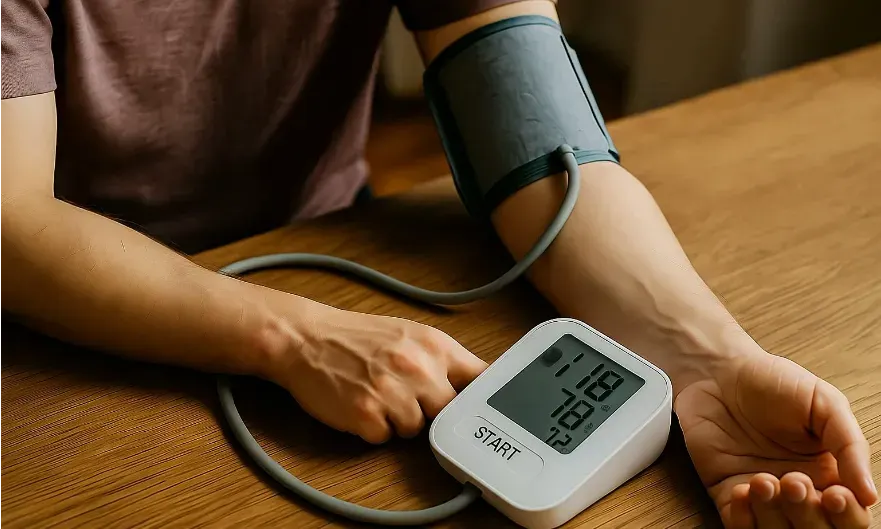Tips for Lowering Your Blood Pressure and Reducing Chronic Disease Risk

Key takeaways
- Blood pressure above 140/90 mmHg increases risk of stroke, heart failure, and kidney disease.
- Lifestyle factors—diet, activity, stress, sleep—can lower blood pressure naturally.
- Aim for readings near 120/80 mmHg through diet, exercise, and metabolic health improvement.
- Reduce sodium, increase potassium, and follow a DASH or Mediterranean eating pattern.
- When lifestyle isn’t enough, medications can provide vital protection from long-term damage.
While medications save lives when needed, most cases of mildly elevated blood pressure—what’s now called pre-hypertension or stage 1 hypertension—respond remarkably well to simple, consistent lifestyle changes. The key is acting early, before damage accumulates.
Why Blood Pressure Matters More Than You Think
The Link Between Blood Pressure and Chronic Disease
Hypertension accelerates wear and tear across three vital systems: the brain, the heart, and the kidneys. Persistent high pressure damages small vessels, stiffens arteries, and makes the heart work harder. Over time, this raises the risk of stroke, heart failure, and kidney disease—the “big three” complications most closely tied to blood pressure.The 120/80 vs. 140/90 Debate
Most global guidelines define hypertension as blood pressure above 140/90 mmHg, while U.S. standards now classify anything above 130/80 mmHg as elevated. Critics argue the lower cutoff risks “medicalizing” half the adult population, but both camps agree: the lower your average blood pressure (within reason), the better your long-term health.
How Lifestyle Shapes Your Numbers
1. Improve Metabolic Health
Blood pressure doesn’t exist in isolation—it’s part of the broader metabolic picture. Insulin resistance, obesity, and elevated triglycerides all increase vascular tension. By improving metabolic health through weight management and glucose control, you reduce blood pressure naturally.
2. Move More, Sit Less
Exercise is one of the most effective “drugs” for blood pressure. A mix of aerobic training (brisk walking, cycling, swimming) and strength training improves vascular elasticity and nitric oxide production, helping vessels relax. Even light activity throughout the day—standing breaks, short walks after meals—keeps pressure from creeping upward.Aiming for 150 minutes of moderate activity per week can reduce systolic pressure by 5–8 mmHg, similar to a first-line medication in some studies.
Nutrition Strategies That Make a Real Difference
Reduce Sodium, Rebalance Potassium
Excess sodium intake remains a major driver of hypertension, especially in processed food–heavy diets. Cutting back to about 2,000 mg of sodium per day can significantly lower blood pressure in sensitive individuals. Equally important is increasing potassium-rich foods like bananas, spinach, avocados, and beans, which counterbalance sodium’s effects.
Adopt the DASH or Mediterranean Pattern
Both the DASH (Dietary Approaches to Stop Hypertension) and Mediterranean diets emphasize fruits, vegetables, legumes, nuts, lean proteins, and healthy fats such as olive oil. They’re naturally rich in magnesium, fiber, and antioxidants—all nutrients linked to healthier arteries and improved kidney function.
The Role of the Kidneys: Your Body’s Pressure Regulators
Why the Kidneys Are So Sensitive to Pressure
The kidneys act like built-in pressure sensors, constantly filtering blood and fine-tuning fluid balance. When pressure is chronically elevated, tiny glomeruli (filtration units) sustain micro-injuries that lead to scarring and gradual decline in function. Over decades, that process contributes to chronic kidney disease (CKD)—often without symptoms until advanced stages.
Kidney-Friendly Habits
- Stay hydrated but avoid overhydration.
- Manage salt and protein intake within healthy ranges.
- Keep blood sugar and blood pressure in check through lifestyle first.
- Avoid unnecessary NSAIDs (which can elevate pressure and harm kidney filtration).
When Lifestyle Isn’t Enough
Sometimes, even with diligent habits, blood pressure remains stubbornly high. That’s where medication becomes a valuable ally. For persistent readings above 140/90 mmHg despite lifestyle changes, antihypertensive drugs can significantly reduce long-term cardiovascular and renal risk.
Practical Tips to Keep Your Pressure in Check
- Check it at home. Track your blood pressure regularly—morning and evening readings, averaged over several days, are most accurate.
- Mind your sleep. Poor sleep and sleep apnea can elevate blood pressure; aim for 7–9 hours and address snoring if present.
- Limit alcohol. Even moderate drinking can raise systolic pressure; stay within one drink per day (women) or two (men).
- Manage stress. Deep breathing, walking, time outdoors, and meditation all help calm the nervous system and lower pressure.
- Don’t forget your doctor visits. Early detection allows intervention before damage sets in.
The Bottom Line
High blood pressure is both preventable and treatable. For most people sitting near the borderline, the best medicine is movement, nutrient-dense eating, and consistent sleep—not necessarily a pill. By restoring metabolic health and managing stress, you can not only normalize your numbers but also protect your heart, brain, and kidneys for decades to come.
References:
· https://pmc.ncbi.nlm.nih.gov/articles/PMC6780911/
· https://pubmed.ncbi.nlm.nih.gov/35211753/
· https://pmc.ncbi.nlm.nih.gov/articles/PMC10713007/
· https://pmc.ncbi.nlm.nih.gov/articles/PMC11837816/
· https://pmc.ncbi.nlm.nih.gov/articles/PMC10246465/
